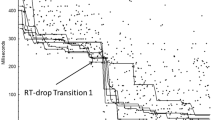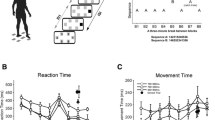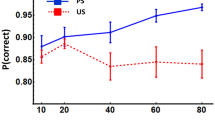Abstract
In two experiments with the serial reaction-time task, participants were presented with deterministic or probabilistic sequences under single- or dual-task conditions. Experiment 1 showed that learning of a probabilistic structure was not impaired over a first session by performing a counting task, but that such an interference arose over a second session, when the knowledge was tested under single-task conditions. In contrast, the effects of the secondary task arose earlier for participants exposed to deterministic sequences. This difference between deterministic and probabilistic sequences disappeared in Experiment 2, where the counting task was performed on tones associated to the locations. Comparisons between sessions indicated that the secondary task affected not only the expression but also the acquisition of sequence learning, and that greater interference was observed in those conditions that yielded more explicit knowledge. These results suggest that the effects of a dual task on the measures of implicit sequence learning may be partly due to the intrusion of explicit knowledge and partly due to the disruption of the sequence produced by the inclusion of random events.



Similar content being viewed by others
References
Barsalou, L. (1995). Storage side-effects: Studying processing to understand learning. In A. Ram & D. B. Leake (Eds.), Goal-driven learning (pp. 407–419). Cambridge, MA: MIT Press.
Cleeremans, A., & Jiménez, L. (1998). Implicit sequence learning: The truth is in the details. In M. A. Stadler & P. A. Frensch (Eds.), Handbook of implicit learning (pp. 323–364). Thousand Oaks, CA: Sage.
Cleeremans, A., & Jiménez, L. (2002). Implicit learning and consciousness: A graded, dynamic perspective. In R. M. French & A. Cleeremans (Eds.), Implicit learning and consciousness: An empirical, computational and philosophical consensus in the making? (pp. 1–40). Hove, UK: Psychology Press.
Cleeremans, A., Destrebecqz, A., & Boyer, C. (1998). Implicit learning: News from the front. Trends in Cognitive Sciences, 2, 406–416.
Cohen, A., Ivry, R. I., & Keele, S. W. (1990). Attention and structure in sequence learning. Journal of Experimental Psychology: Learning, Memory, and Cognition, 16, 17–30.
Curran, T., & Keele, S. W. (1993). Attentional and nonattentional forms of sequence learning. Journal of Experimental Psychology: Learning, Memory, and Cognition, 19, 189–202.
Destrebecqz, A., & Cleeremans, A. (2001). Can sequence learning be implicit? New evidence with the process dissociation procedure. Psychonomic Bulletin & Review, 8, 343–350.
Destrebecqz, A., & Cleeremans, A. (2003). Temporal effects in sequence learning. In L. Jiménez (Ed.), Attention and implicit learning (pp. 181–213). Amsterdam: Benjamins.
Dienes, Z., & Berry, D. (1997). Implicit learning: Below the subjective threshold. Psychonomic Bulletin and Review, 4, 3–33.
Frensch, P. A. (1998). One concept, multiple meanings: On how to define implicit learning. In M. A. Stadler & P. A. Frensch (Eds.), Handbook of implicit learning (pp. 47–104). Thousand Oaks, CA: Sage.
Frensch, P. A., Buchner, A., & Lin J. (1994). Implicit learning of unique and ambiguous serial transitions in the presence and absence of a distractor task. Journal of Experimental Psychology: Learning, Memory, and Cognition, 20, 567–584.
Frensch, P. A., Haider, H., Rünger, D., Neugebauer, U., Voigt, S., Werg, J. (2003). The route from implicit learning to verbal expression of what has been learned: Verbal report of incidentally experienced environmental regularity. In L. Jiménez (Ed.), Attention and implicit learning (pp. 335–366). Amsterdam: Benjamins.
Frensch, P. A., Lin, J., & Buchner, A. (1998). Learning versus behavioral expression of the learned: The effects of a secondary tone-counting task on implicit learning in the serial reaction time task. Psychological Research, 61, 83–98.
Frensch, P. A., & Miner, C. S. (1994). Effects of presentation rate and individual differences in short-term memory capacity on an indirect measure of serial memory. Memory & Cognition, 22, 95–110.
Frensch, P. A., Wenke, D., & Rünger, D. (1999). A secondary tone-counting task suppresses expression of knowledge in the serial reaction task. Journal of Experimental Psychology: Learning, Memory, and Cognition, 25, 260–274.
Hsiao, A. T., & Reber, A. S. (1998). The role of attention in implicit sequence learning: Exploring the limits of the cognitive unconscious. In M. A. Stadler & P. A. Frensch (Eds.), Handbook of implicit learning (pp. 471–494). Thousand Oaks, CA: Sage.
Jiménez, L. (2003). Intention, attention, and consciousness in probabilistic sequence learning. In L. Jiménez (Ed.), Attention and implicit learning (pp. 43–70). Amsterdam: Benjamins.
Jiménez, L., & Méndez, C. (1999). Which attention is needed for implicit sequence learning? Journal of Experimental Psychology: Learning, Memory, and Cognition, 25, 236–259.
Jiménez, L., & Méndez, C. (2001). Implicit sequence learning with competing explicit cues. Quarterly Journal of Experimental Psychology (A), 54, 345–369.
Jiménez, L., Méndez, C., & Cleeremans, A. (1996). Direct and indirect measures of sequence learning. Journal of Experimental Psychology: Learning, Memory, and Cognition, 22, 948–969.
Keele, S. W., Ivry, R., Mayr, U., Hazeltine, E., & Heuer, H. (2003). The cognitive and neural architecture of sequence representation. Psychological Review, 110, 316–339.
Nissen, M. J., & Bullemer, P. (1987). Attentional requirements of learning: Evidence from performance measures. Cognitive Psychology, 19, 1–32.
Rah, S., Reber, A. S., & Hsiao, A. T. (2000) Another wrinkle on the dual-task SRT experiment: It’s probably not dual-task. Psychonomic Bulletin and Review, 7, 309–313.
Reed, J., & Johnson, P. (1994). Assessing implicit learning with indirect tests: Determining what is learnt about sequence structure. Journal of Experimental Psychology: Learning, Memory, and Cognition, 20, 585–594.
Reingold, E. M., & Merikle, P. (1988). Using direct and indirect measures to study perception without awareness. Perception and Psychophysics, 44, 563–575.
Schmidtke, V., & Heuer, H. (1997). Task integration as a factor in secondary-task effects on sequence learning. Psychological Research, 60, 53–71.
Schvaneveldt, R. W., & Gomez, R. (1998). Attention and probabilistic sequence learning. Psychological Research, 61, 175–190.
Shanks, D. R. (2003). Attention and awareness in “implicit” sequence learning. In L. Jiménez (Ed.), Attention and implicit learning (pp. 11–42). Amsterdam: Benjamins.
Shanks, D. R., & Channon, S. (2002). Effects of a secondary task on “implicit” sequence learning: Learning or performance? Psychological Research, 66, 99–109.
Shanks, D. R., & Perruchet, P. (2002). Dissociation between priming and recognition in the expression of sequential knowledge. Psychonomic Bulletin and Review,9, 362–367.
Shanks, D. R., & St. John, M. (1994). Characteristics of dissociable human learning systems. Behavioral and Brain Sciences, 17, 367–447.
Shanks, D. R., Wilkinson, L., & Channon, S. (2003). Relationship between priming and recognition in deterministic and probabilistic sequence learning. Journal of Experimental Psychology: Learning, Memory, and Cognition, 29, 248–261.
Stadler, M. (1995). The role of attention in implicit learning. Journal of Experimental Psychology: Learning, Memory, and Cognition, 21, 674–685.
Wilkinson, L., & Shanks, D. R. (2004). Intentional control and implicit sequence learning. Journal of Experimental Psychology: Learning, Memory, and Cognition, 30, 354–369.
Willingham, D. B., Greenberg, A. R., & Thomas, R. C. (1997). Response-to-stimulus interval does not affect implicit motor sequence learning, but does affect performance. Memory and Cognition, 25, 534–542.
Acknowledgements
This research was supported by grants PB97–0525 and BSO2003–05095 from the Ministerio de Educación (Spain). The authors wish to thank George Mandler and David R. Shanks for their insightful comments on a previous version of this manuscript.
Author information
Authors and Affiliations
Corresponding author
Rights and permissions
About this article
Cite this article
Jiménez, L., Vázquez, G.A. Sequence learning under dual-task conditions: alternatives to a resource-based account. Psychological Research 69, 352–368 (2005). https://doi.org/10.1007/s00426-004-0210-9
Received:
Accepted:
Published:
Issue Date:
DOI: https://doi.org/10.1007/s00426-004-0210-9




